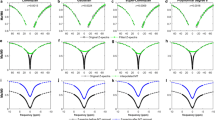Abstract
Purpose
To evaluate the effects of a reference image and keyhole factor (Kf) selections for high-frequency substitution on keyhole imaging technique for applications in glutamate chemical exchange saturation transfer (GluCEST) imaging.
Procedures
The CEST data were obtained using a 7.0 T MRI scanner. We used varied Kf ranges that constituted from 16.67 to 75 % of the full k-space. The reference image was respectively selected for − 3 and + 3 ppm images that associated with the GluCEST calculation and the unsaturated image. The zero-padding algorithm was applied for the missing k-space lines in the low-frequency data collected to compare the results obtained from using the keyhole imaging technique. All the techniques were evaluated using a healthy rat group and extended to the status epilepticus rat group to explore their applicability and usability.
Results
The calculated GluCEST signals and visually inspected results from the reconstructed GluCEST maps indicated that the combination of unsaturated image as a reference image, and over 50 % of Kf showed consistent signals and image quality compared with the fully sampled CEST data.
Conclusions
Combining the keyhole imaging technique with GluCEST imaging enables stable image reconstruction and quantitative evaluation, and this approach is potentially applicable in various CEST imaging applications.





Similar content being viewed by others
References
Dula AN, Smith SA, Gore JC (2013) Application of chemical exchange saturation transfer (CEST) MRI for endogenous contrast at 7 tesla. J Neuroimaging 23:526–532
Jones KM, Pollard AC, Pagel MD (2018) Clinical applications of chemical exchange saturation transfer (CEST) MRI. J Magn Reson Imaging 47:11–27
van Zijl PCM, Yadav NN (2011) Chemical exchange saturation transfer (CEST): what is in a name and what isn’t? Magn Reson Med 65:927–948
Zhou J, Blakeley JO, Hua J et al (2008) Practical data acquisition method for human brain tumor amide proton transfer (APT) imaging. Magn Reson Med 60:842–849
Lustig M, Donoho D, Pauly JM (2007) Sparse MRI: the application of compressed sensing for rapid MR imaging. Magn Reson Med 58:1182–1195
Hu X (1994) On the “keyhole” technique. J Magn Reson Imaging 4:231
Hu X, Parrish T (1994) Reduction of field of view for dynamic imaging. Magn Reson Med 31:691–694
She H, Greer JS, Zhang S et al (2019) Accelerating chemical exchange saturation transfer MRI with parallel blind compressed sensing. Magn Reson Med 81:504–513
Jaspan ON, Fleysher R, Lipton ML (2015) Compressed sensing MRI: a review of the clinical literature. Br J Radiol 88:20150487
Heo HY, Zhang Y, Lee DH, Jiang S, Zhao X, Zhou J (2017) Accelerating chemical exchange saturation transfer (CEST) MRI by combining compressed sensing and sensitivity encoding techniques. Magn Reson Med 77:779–786
Varma G, Lenkinski RE, Vinogradov E (2012) Keyhole chemical exchange saturation transfer. Magn Reson Med 68:1228–1233
Cai KJ, Haris M, Singh A et al (2012) Magnetic resonance imaging of glutamate. Nat Med 18:302–306
Singh A, Cai KJ, Haris M, Hariharan H, Reddy R (2013) On B1 inhomogeneity correction of in vivo human brain glutamate chemical exchange saturation transfer contrast at 7T. Magn Reson Med 69:818–824
Du YP, Parker DL, Davis WL, Cao G (1994) Reduction of partial-volume artifacts with zero-filled interpolation in three-dimensional MR angiography. J Magn Reson Imaging 4:733–741
Lee DH, Lee DW, Kwon JI et al (2019) In vivo mapping and quantification of creatine using chemical exchange saturation transfer imaging in rat models of epileptic seizure. Mol Imaging Biol 21:232–239
Sperk G (1994) Kainic acid seizures in the rat. Prog Neurobiol 42:1–32
Park J, Zhang Q, Jellus V, Simonetti O, Li D (2005) Artifact and noise suppression in GRAPPA imaging using improved k-space coil calibration and variable density sampling. Magn Reson Med 53:186–193
Xiao Z, Hoge WS, Mulkern RV, Zhao L, Hu G, Kyriakos WE (2008) Comparison of parallel MRI reconstruction methods for accelerated 3D fast spin-echo imaging. Magn Reson Med 60:650–660
Mogatadakala KV, Bankson JA, Narayana PA (2008) Three-element phased-array coil for imaging of rat spinal cord at 7T. Magn Reson Med 60:1498–1505
Herrmann KH, Schmidt S, Kretz A et al (2012) Possibilities and limitations for high resolution small animal MRI on a clinical whole-body 3T scanner. Magn Reson Mater Phy 25:233–244
Lee DH, Lee DW, Kwon JI et al (2019) Retrospective brain motion correction in glutamate chemical exchange saturation transfer (GluCEST) MRI. Mol Imaging Biol 21:1064–1070
Davis KA, Nanga RPR, Das S et al (2015) Glutamate imaging (GluCEST) lateralizes epileptic foci in nonlesional temporal lobe epilepsy. Sci Transl Med 7(309):309ra161.https://doi.org/10.1126/scitranslmed.aaa7095
Jones CK, Polders D, Hua J et al (2012) In vivo three-dimensional whole-brain pulsed steady-state chemical exchange saturation transfer at 7 T. Magn Reson Med 67:1579–1589
Zaiss M, Xu JZ, Goerke S et al (2014) Inverse Z-spectrum analysis for spillover-, MT-, and T-1-corrected steady-state pulsed CEST-MRI - application to pHweighted MRI of acute stroke. NMR Biomed 27:240–252
Funding
This study was supported by grants from the Basic Science Research Program through the National Research Foundation of Korea [NRF-2018R1C1B6004521; NRF-2017R1A6A3A03012461; and NRF-2018R1A2B2007694] and the Korea Health Technology R&D Project through the Korea Health Industry Development Institute [HI14C1090], funded by the Ministry of Health & Welfare, Republic of Korea.
Author information
Authors and Affiliations
Corresponding authors
Ethics declarations
Conflict of Interest
The authors of this manuscript declare that they have no conflicts of interest.
Additional information
Publisher’s Note
Springer Nature remains neutral with regard to jurisdictional claims in published maps and institutional affiliations.
Rights and permissions
About this article
Cite this article
Lee, DH., Lee, DW., Woo, CW. et al. Optimization of Keyhole Imaging Parameters for Glutamate Chemical Exchange Saturation Transfer MRI at 7.0 T. Mol Imaging Biol 22, 924–930 (2020). https://doi.org/10.1007/s11307-019-01461-z
Published:
Issue Date:
DOI: https://doi.org/10.1007/s11307-019-01461-z




